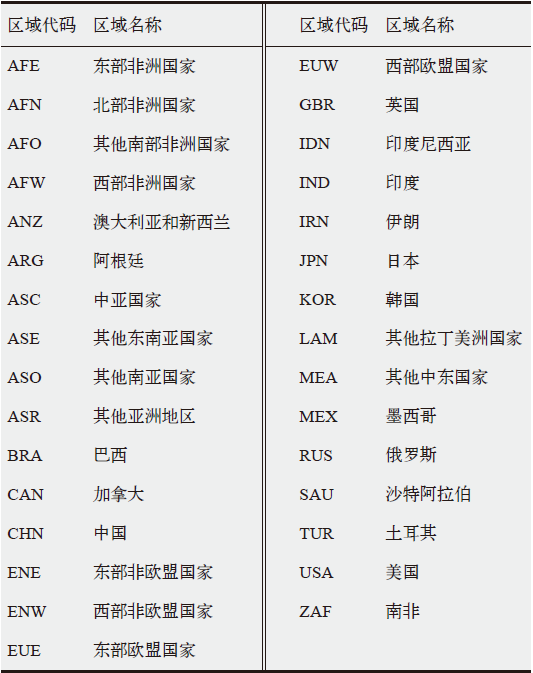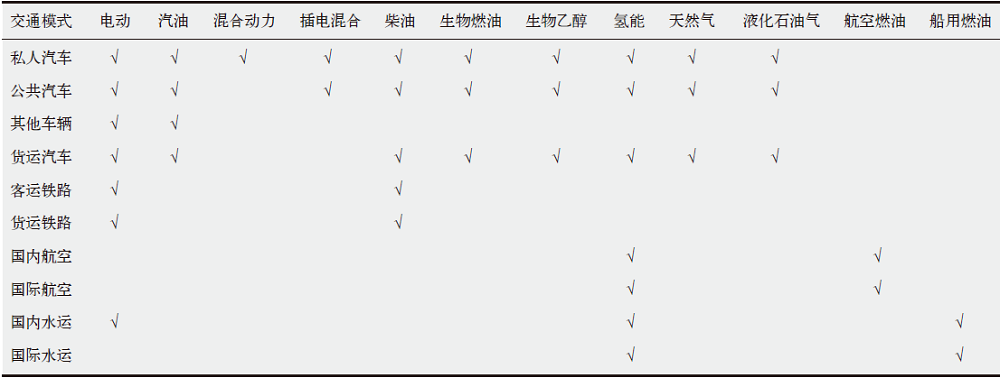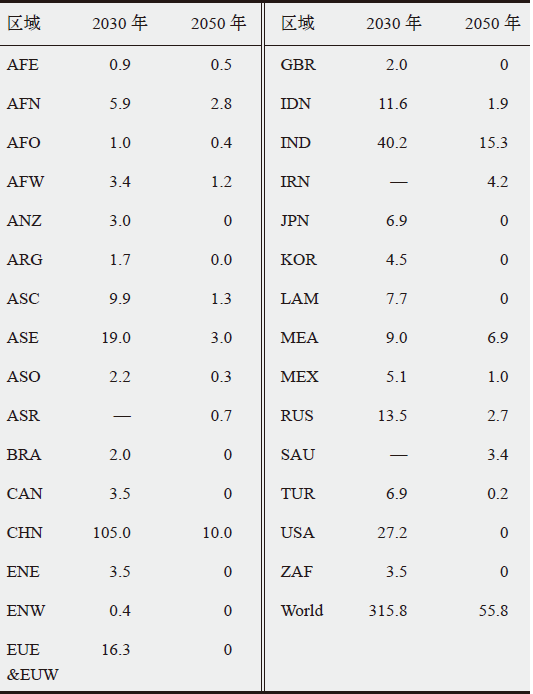Climate Change Research ›› 2023, Vol. 19 ›› Issue (2): 203-212.doi: 10.12006/j.issn.1673-1719.2022.184
• Greenhouse Gas Emissions • Previous Articles Next Articles
Global transportation energy transition pathways towards carbon neutrality
LI Dan-Yang1,2( ), CHEN Wen-Ying1,2
), CHEN Wen-Ying1,2
- 1 Research Center for Contemporary Management, Tsinghua University, Beijing 100084, China
2 Institute of Energy, Environment and Economy, Tsinghua University, Beijing 100084, China
-
Received:2022-08-04Revised:2022-11-14Online:2023-03-30Published:2023-02-03
Cite this article
LI Dan-Yang, CHEN Wen-Ying. Global transportation energy transition pathways towards carbon neutrality[J]. Climate Change Research, 2023, 19(2): 203-212.
share this article
Add to citation manager EndNote|Ris|BibTeX
URL: https://www.climatechange.cn/EN/10.12006/j.issn.1673-1719.2022.184
| [1] | United Nations Framework Convention on Climate Change (UNFCCC). Adoption of the Paris Agreement[R]. Paris, 2015 |
| [2] |
Kyle P, Kim S H. Long-term implications of alternative light-duty vehicle technologies for global greenhouse gas emissions and primary energy demands[J]. Energy Policy, 2011, 39 (5): 3012-3024
doi: 10.1016/j.enpol.2011.03.016 URL |
| [3] |
Pietzcker R C, Longden T, Chen W, et al. Long-term transport energy demand and climate policy: alternative visions on transport decarbonization in energy-economy models[J]. Energy, 2014, 64: 95-108
doi: 10.1016/j.energy.2013.08.059 URL |
| [4] |
Yin X, Chen W, Eom J, et al. China’s transportation energy consumption and CO2 emissions from a global perspective[J]. Energy Policy, 2015, 82: 233-248
doi: 10.1016/j.enpol.2015.03.021 URL |
| [5] |
Hache E, Seck G S, Simoen M, et al. Critical raw materials and transportation sector electrification: a detailed bottom-up analysis in world transport[J]. Applied Energy, 2019, 240: 6-25
doi: 10.1016/j.apenergy.2019.02.057 URL |
| [6] |
Zhang R, Fujimori S, Dai H, et al. Contribution of the transport sector to climate change mitigation: insights from a global passenger transport model coupled with a Computable General Equilibrium model[J]. Applied Energy, 2018, 211: 76-88
doi: 10.1016/j.apenergy.2017.10.103 URL |
| [7] |
Mittal S, Dai H, Fujimori S, et al. Key factors influencing the global passenger transport dynamics using the AIM/transport model[J]. Transportation Research Part D: Transport and Environment, 2017, 55: 373-388
doi: 10.1016/j.trd.2016.10.006 URL |
| [8] |
Ruhnau O, Bannik S, Otten S, et al. Direct or indirect electrification? A review of heat generation and road transport decarbonisation scenarios for Germany 2050[J]. Energy, 2019, 166: 989-999
doi: 10.1016/j.energy.2018.10.114 URL |
| [9] |
Andress D, Nguyen T D, Das S. Reducing GHG emissions in the United States’ transportation sector[J]. Energy for Sustainable Development, 2011, 15 (2): 117-136
doi: 10.1016/j.esd.2011.03.002 URL |
| [10] |
Haasz T, Gómez Vilchez J J, Kunze R, et al. Perspectives on decarbonizing the transport sector in the EU-28[J]. Energy Strategy Reviews, 2018, 20: 124-132
doi: 10.1016/j.esr.2017.12.007 URL |
| [11] |
Li Y, Chang Y. Road transport electrification and energy security in the association of Southeast Asian nations: quantitative analysis and policy implications[J]. Energy Policy, 2019, 129: 805-815
doi: 10.1016/j.enpol.2019.02.048 URL |
| [12] |
Talebian H, Herrera O E, Tran M, et al. Electrification of road freight transport: policy implications in British Columbia[J]. Energy Policy, 2018, 115: 109-118
doi: 10.1016/j.enpol.2018.01.004 URL |
| [13] |
Pan X, Wang H, Wang L, et al. Decarbonization of China’s transportation sector: in light of national mitigation toward the Paris Agreement goals[J]. Energy, 2018, 155: 853-864
doi: 10.1016/j.energy.2018.04.144 URL |
| [14] |
Khanna N, Fridley D, Zhou N, et al. Energy and CO2 implications of decarbonization strategies for China beyond efficiency: modeling 2050 maximum renewable resources and accelerated electrification impacts[J]. Applied Energy, 2019, 242: 12-26
doi: 10.1016/j.apenergy.2019.03.116 |
| [15] |
Peng T, Ou X, Yuan Z, et al. Development and application of China provincial road transport energy demand and GHG emissions analysis model[J]. Applied Energy, 2018, 222: 313-328
doi: 10.1016/j.apenergy.2018.03.139 URL |
| [16] |
Zhao F, Liu F, Liu Z, et al. The correlated impacts of fuel consumption improvements and vehicle electrification on vehicle greenhouse gas emissions in China[J]. Journal of Cleaner Production, 2019, 207: 702-716
doi: 10.1016/j.jclepro.2018.10.046 URL |
| [17] |
Wang H, Ou X, Zhang X. Mode, technology, energy consumption, and resulting CO2 emissions in China’s transport sector up to 2050[J]. Energy Policy, 2017, 109: 719-733
doi: 10.1016/j.enpol.2017.07.010 URL |
| [18] |
Zhao L, Chang S, Wang H, et al. Long-term projections of liquid biofuels in China: uncertainties and potential benefits[J]. Energy, 2015, 83: 37-54
doi: 10.1016/j.energy.2015.01.060 URL |
| [19] |
Li P, Zhao P, Brand C. Future energy use and CO2 emissions of urban passenger transport in China: a travel behavior and urban form based approach[J]. Applied Energy, 2018, 211: 820-842
doi: 10.1016/j.apenergy.2017.11.022 URL |
| [20] |
Hao H, Geng Y, Li W, et al. Energy consumption and GHG emissions from China’s freight transport sector: scenarios through 2050[J]. Energy Policy, 2015, 85: 94-101
doi: 10.1016/j.enpol.2015.05.016 URL |
| [21] | Loulou R, Remne U, Kanudia A, et al. Documentation for the TIMES model: part 1[EB/OL]. 2005 [2021-03-01]. https://iea-etsap.org/index.php/documentation |
| [22] | International Energy Agency (IEA). World energy balances[EB/OL]. 2021 [2021-08-01]. http://data.iea.org |
| [23] | International Institute for Applied Systems Analysis. SSP public database-version 2.0[EB/OL]. 2018 [2021-08-01]. https://tntcat.iiasa.ac.at/SspDb/dsd?Action=htmlpage&page=welcome |
| [24] | International Organization of Motor Vehicle Manufacturers. World vehicles in use[EB/OL]. 2016 [2021-08-01]. https://www.oica.net/category/vehicles-in-use/ |
| [25] |
Huo H, Wang M. Modeling future vehicle sales and stock in China[J]. Energy Policy, 2012, 43: 17-29
doi: 10.1016/j.enpol.2011.09.063 URL |
| [26] | International Civil Aviation Organization (ICAO). Annual report 2018: air transport statistics[EB/OL]. 2018 [2021-08-01]. https://www.icao.int/annual-report-2018/Pages/the-world-of-air-transport-in-2018-statistical-results.aspx |
| [27] | International Union of Railways. Railisa: UIC statistics[EB/OL]. 2021 [2021-08-01]. https://uic-stats.uic.org/ |
| [28] | Joint Global Change Research Institute. Global Change Analysis Model (GCAM)[EB/OL]. 2019 [2019-09-05]. http://www.globalchange.umd.edu/gcam/ |
| [29] | Mishra G S, Kyle P, Teter J, et al. Transportation module of Global Change Assessment Model (GCAM) model documentation[EB/OL]. 2021 [2021-09-01]. https://escholarship.org/uc/item/8nk2c96d |
| [1] | ZHANG Ren-He. Scientific issues concerning the carbon neutrality [J]. Climate Change Research, 2024, 20(6): 661-668. |
| [2] | CHAI Qi-Min, LIU Bo-Han, MA Yu-Jie, XIE Rui-Li, LI Mo-Yu. Global Stocktake of energy transition and technological innovation: progress and assessment [J]. Climate Change Research, 2024, 20(6): 747-756. |
| [3] | AN Feng-Quan, XIE Hong-Li, LI Chang-Sheng, LIU Shao-Hui. COP28 new consensus on energy transition and its analysis [J]. Climate Change Research, 2024, 20(6): 757-763. |
| [4] | ZHANG Gui-Chi, LI Xiao-Mei, YANG Feng, SUN Rui-Ling. Working ideas of urban reduction of pollution and carbon emissions management: based on great inventory management system [J]. Climate Change Research, 2024, 20(1): 75-84. |
| [5] | YANG Zi-Yi, HU Shan, XU Tian-Hao, YAN Da, JIANG Yi. Method and application of global building operation energy use and carbon emissions comparison in the context of carbon neutrality [J]. Climate Change Research, 2023, 19(6): 749-760. |
| [6] | TIAN Pei-Ning, MAO Bao-Hua, TONG Rui-Yong, ZHANG Hao-Xiang, ZHOU Qi. Analysis of carbon emission level and intensity of China’s transportation industry and different transportation modes [J]. Climate Change Research, 2023, 19(3): 347-356. |
| [7] | XU Tian-Hao, HU Shan, YANG Zi-Yi, JIANG Yi. Carbon emission comparisons of the building sector between China and Sweden and its implication for achieving carbon neutrality in the building sector of China [J]. Climate Change Research, 2023, 19(3): 305-319. |
| [8] | YANG Shan-Shan, GUO Hao, YANG Xiu, LI Zheng. Consideration and prospect of total carbon emission control system under the double carbon target [J]. Climate Change Research, 2023, 19(2): 191-202. |
| [9] | LI Pin, XIE Xiao-Min, HUANG Zhen. The process of Germany energiewende and its enlightenment to China [J]. Climate Change Research, 2023, 19(1): 116-126. |
| [10] | FAN Xing, LI Lu, QIN Yuan-Yuan, GAO Xiang. The pathway from carbon peak to carbon neutrality in major developed economies and its insights [J]. Climate Change Research, 2023, 19(1): 102-115. |
| [11] | LIN Ze-Wei, WANG Peng, REN Song-Yan, XU Hong-Wei, ZHANG Cong, ZHAO Dai-Qing. Assessment of economic, environmental and health benefits of the energy transition path—take the Guangdong-Hong Kong-Macao Greater Bay Area as an example [J]. Climate Change Research, 2022, 18(6): 777-790. |
| [12] | BAI Quan, HU Shan, GU Li-Jing. Interpretation of IPCC AR6 on buildings [J]. Climate Change Research, 2022, 18(5): 557-566. |
| [13] | GUO Si-Yue, GENG Yong. Interpretation of IPCC AR6 on mitigation in industry [J]. Climate Change Research, 2022, 18(5): 574-579. |
| [14] | YAN Shu-Qi, LI Su-Mei, LYU He, CHEN Sha, LIU Ying-Ying, WANG Hong-Tao, LIU Hui-Zheng, CHEN Qian-Li. Water footprint analysis of electricity production in Xinjiang Uygur Autonomous Region based on a hybrid LCA model and its changes under carbon neutralization target [J]. Climate Change Research, 2022, 18(3): 294-304. |
| [15] | ZHANG Hao-Nan, SHEN Rong-Rong, ZHANG Xing-Ping, KANG Jun-Jie, YUAN Jia-Hai. Implications and pathways of China's carbon neutrality: a review [J]. Climate Change Research, 2022, 18(2): 240-252. |
| Viewed | ||||||
|
Full text |
|
|||||
|
Abstract |
|
|||||








